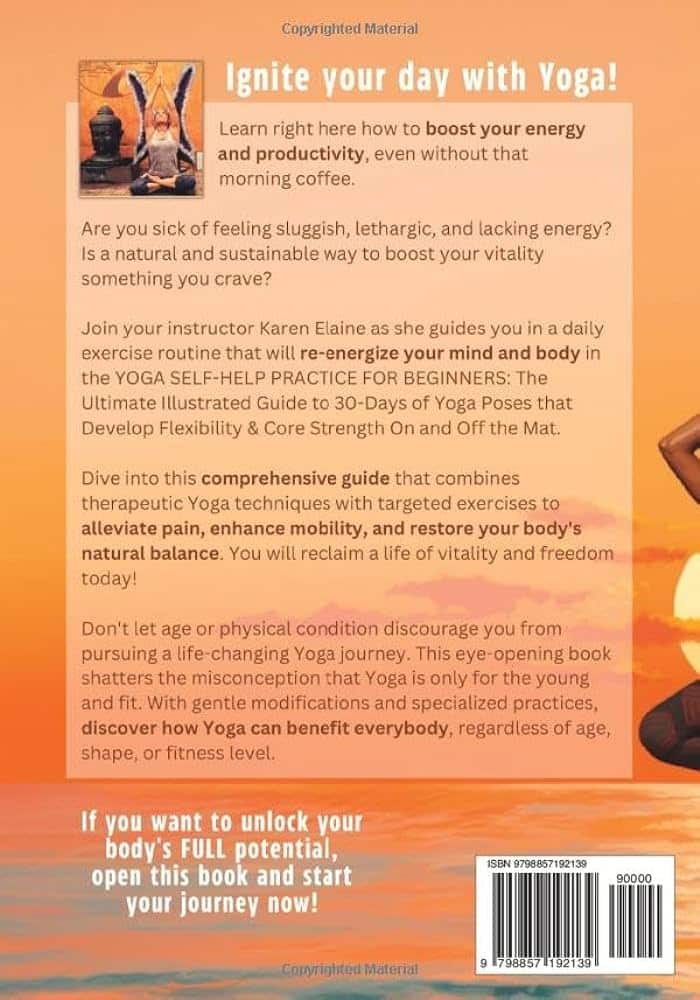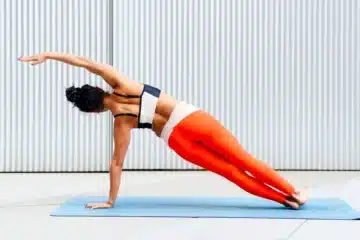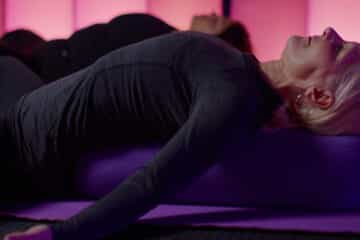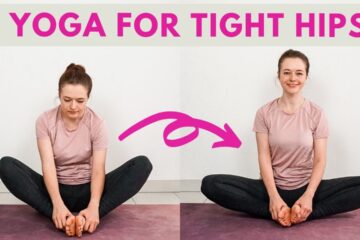Looking to relieve back pain through yoga? This beginners guide will help you get started with simple and effective yoga poses and stretches.
Yoga has been shown to improve flexibility, reduce muscle tension, and promote relaxation, all of which can contribute to back pain relief. In this guide, you will learn about various yoga poses and sequences specifically designed to target and alleviate back pain.
Whether you’re new to yoga or looking to add gentle movements to your routine, incorporating these practices can help you find relief and support your overall back health. Let’s explore how yoga can be an accessible and impactful way to ease discomfort and promote healing in the back.

Credit: www.amazon.com
What Is Yoga?
What is yoga?
Yoga is an ancient practice that originated in India and focuses on creating harmony between the mind, body, and spirit. It involves a combination of physical postures, breathing exercises, and meditation techniques designed to promote physical strength, flexibility, and mental well-being.
Origin Of Yoga
The history of yoga can be traced back over 5,000 years to ancient India, where it was developed as a spiritual and ascetic discipline by the sages and saints. It has evolved over time, with various schools of yoga emerging to emphasize different aspects of the practice, including hatha, vinyasa, and ashtanga yoga.
Benefits Of Yoga
Yoga offers a wide range of benefits for both the body and mind. Some of the key advantages include:
- Improved flexibility and strength
- Reduced stress and anxiety
- Enhanced posture and balance
- Relief from back pain and other physical discomforts
With consistent practice, yoga can help individuals build a strong and resilient body while fostering a sense of calm and inner peace.
Understanding Back Pain
Understanding back pain is crucial for those seeking relief through yoga. Back pain can impact daily life and hinder mobility, making it essential to grasp its causes and effects. As a beginner, gaining insight into back pain is the first step toward finding relief.
Causes Of Back Pain
1. Poor posture
2. Overuse of muscles
3. Sedentary lifestyle
Impact Of Back Pain On Daily Life
1. Difficulty in performing routine activities
2. Reduced mobility and flexibility
3. Lowered quality of life
How Can Yoga Help With Back Pain?
Yoga offers a beginner-friendly approach to relieving back pain by improving flexibility, strengthening muscles, and promoting relaxation. Regular yoga practice can help alleviate discomfort and improve overall spinal health.
Yoga has been practiced for centuries and is known for its numerous physical and mental health benefits. When it comes to back pain relief, yoga can be an effective and natural solution. It helps address the root causes of back pain, such as muscle imbalances, poor posture, and lack of flexibility. By incorporating specific yoga poses and practices into your routine, you can strengthen your core, improve flexibility, and reduce muscle tension, ultimately finding relief from back pain.
Strengthening The Core
One of the key ways that yoga can help with back pain is by strengthening the core muscles. The core muscles, including the deep abdominal muscles and the muscles of the back and pelvis, provide support and stability to the spine. They help maintain proper posture and alignment, which in turn reduces the strain on the back. Yoga poses that target the core, such as plank, boat pose, and bridge pose, engage these muscles and help build strength over time. Regular practice of these poses can lead to a stronger core and a more stable spine, resulting in decreased back pain.
Improving Flexibility
Another way yoga can alleviate back pain is by improving flexibility. Many people experience back pain due to tight muscles and limited range of motion. Yoga incorporates gentle stretches and movements that can gradually increase flexibility in the muscles of the back, hips, and hamstrings. Poses such as child’s pose, cat-cow stretch, and downward dog specifically target these areas, elongating the muscles and releasing tension. Regular practice of these poses can help loosen tight muscles, improve spinal mobility, and reduce the likelihood of back pain.
Reducing Muscle Tension
Yoga is also beneficial for reducing muscle tension, which often contributes to back pain. Certain poses and breathing techniques help relax the muscles and release the built-up tension in the body. Asanas like cobra pose, supine twist, and pigeon pose gently stretch and elongate the back muscles, relieving any tightness or discomfort. Moreover, conscious deep breathing and relaxation techniques incorporated in yoga practice can promote overall relaxation and stress reduction, which can indirectly alleviate muscle tension and provide relief from back pain. Incorporating yoga into your routine can provide long-term relief from back pain. By strengthening the core, improving flexibility, and reducing muscle tension, yoga addresses the root causes of back pain and helps promote a healthy back. Practice these poses regularly under the guidance of a qualified instructor to maximize the benefits and optimize your back health.

Credit: www.goodreads.com
Yoga Poses For Back Pain Relief
If you are a beginner looking for natural ways to relieve back pain, yoga poses can be your best ally. These gentle and effective poses can help stretch and strengthen the muscles in your back, providing much-needed relief from discomfort. Incorporating these poses into your daily routine can offer long-lasting benefits for your back health. Let’s explore some of the best yoga poses for back pain relief:
Child’s Pose
The Child’s pose, also known as Balasana, is a restorative yoga pose that gently stretches the lower back and relieves tension. To practice this pose:
- Kneel on the floor, keeping your knees hip-width apart.
- Sit back on your heels and slowly lower your torso to the ground, reaching your arms forward.
- Rest your forehead on the mat and allow your body to relax.
- Breathe deeply and hold the pose for a few breaths, feeling the gentle stretch in your back.
Cat-cow Pose
The Cat-Cow pose is a dynamic yoga sequence that enhances spinal flexibility and releases tension in the back. To practice this pose:
- Start on all fours with your hands aligned under your shoulders and your knees under your hips.
- As you inhale, lift your tailbone and chest towards the ceiling, arching your back like a cow.
- Exhale and round your spine, dropping your head and tucking your tailbone like a stretching cat.
- Continue moving between these two poses, synchronizing your breath with the movements.
Downward Facing Dog
The Downward Facing Dog pose, or Adho Mukha Svanasana, is a classic yoga pose that stretches the entire body, providing relief to the back and strengthening the core. To practice this pose:
- Begin on your hands and knees, ensuring that your hands are shoulder-width apart.
- Tuck your toes under and lift your hips upward, straightening your legs to form an inverted V shape.
- Press your palms into the mat, lengthen your spine, and relax your neck.
- Hold the pose for several breaths, feeling the stretch in your back and hamstrings.
Bridge Pose
The Bridge pose, or Setu Bandhasana, is a back-strengthening pose that also relieves stress and tension in the spine. To practice this pose:
- Lie on your back with your knees bent and your feet hip-width apart.
- Place your arms by your sides with your palms facing down.
- As you inhale, press your feet into the ground and lift your hips, creating a bridge with your body.
- Hold the pose for several breaths, engaging your glutes and feeling the stretch in your back.
Triangle Pose
The Triangle pose, or Trikonasana, is a standing pose that stretches and strengthens the entire body, including the back and spine. To practice this pose:
- Stand with your feet wide apart, with your right foot pointing forward and your left foot turned slightly inward.
- Extend your arms out to the sides, parallel to the floor.
- Shift your hips to the left and reach your right hand down towards your right ankle, while lifting your left arm straight up.
- Keep your gaze upward and hold the pose for a few breaths, feeling the lengthening and opening in your back.
These yoga poses for back pain relief can work wonders when incorporated into your daily routine. Remember to listen to your body and modify the poses as needed. Practicing these poses regularly will not only alleviate back pain but also improve your overall flexibility and well-being.
Tips For Beginners
If you are new to yoga and looking to relieve your back pain, it’s important to start slow and listen to your body. By going at your own pace and using the following tips, you can ease into your practice and find the relief you need.
Starting Slow And Listening To Your Body
When starting a yoga practice for back pain relief, it’s crucial to take it easy and listen to what your body is telling you. Remember, yoga is not a competition, and there is no need to push yourself beyond your limits. Start with gentle poses and gradually increase the intensity as you become more comfortable and flexible. By paying attention to how your body feels and respecting its limitations, you can avoid unnecessary strain and injury.
If you experience any pain or discomfort during a pose, modify it or come out of it completely. Remember, discomfort is different from pain, and it’s important to distinguish between the two. Discomfort often arises from the stretching of tight muscles, whereas pain may indicate an underlying issue that needs medical attention. Always listen to your body’s signals and adjust your practice accordingly.
Using Props For Support
Props such as blocks, straps, and bolsters can be incredibly helpful, especially for beginners with back pain. These tools provide extra support and help you maintain proper alignment, allowing you to relax into the poses without straining your back. For example, if you find it challenging to reach the floor in a standing forward bend, using a block can bring the ground closer to you, making the pose more accessible.
Using props also enables you to stay in poses for longer durations, which can aid in releasing tension and tightness in the muscles. Whether it’s a blanket for extra cushioning or a strap to assist with stretching, don’t hesitate to incorporate props into your practice. They are there to support you on your journey to back pain relief.
Seeking Guidance From A Qualified Instructor
If you’re a beginner with back pain, seeking guidance from a qualified yoga instructor is highly recommended. An experienced instructor can help you understand correct alignment, provide modifications, and suggest specific poses for your condition. They will ensure that you are practicing safely and effectively.
A qualified instructor can also assess your individual needs and tailor a practice that targets your back pain. They may recommend specific sequences or variations to address your pain points. By working with an instructor, you can gain a deeper understanding of the practice and receive personalized attention that will enhance your overall experience and progress.
Remember, yoga is a journey, and the key to success lies in consistency, patience, and self-care. Embrace these tips for beginners, and you’ll be well on your way to finding the relief you seek in your yoga practice.
Frequently Asked Questions Of Yoga For Back Pain Relief Beginners Guide
What Type Of Yoga Is Best For Back Pain?
For back pain, gentle yoga styles like Hatha or Iyengar can provide relief. Focus on poses that stretch and strengthen the back. Avoid intense styles. Always consult a doctor before starting any new exercise regime. Regular practice can help alleviate back pain.
Can You Fix Back Pain With Yoga?
Yes, yoga can help alleviate back pain by improving flexibility and strength. Certain yoga poses can reduce muscle tension and improve posture, leading to relief from back discomfort. Regular practice may also prevent future pain.
How Long Does Yoga Take To Fix Back Pain?
Yoga can help alleviate back pain, but the time it takes to see improvement varies. Consistently practicing yoga can lead to gradual relief, but individual results may differ. It is recommended to consult with a healthcare professional for guidance on incorporating yoga into a comprehensive back pain management plan.
Which Yoga Should Be Avoid In Lower Back Pain?
Avoid yoga poses that put excessive strain on the lower back, such as deep forward bends or twists. Instead, opt for gentle poses that stretch and strengthen the back muscles, like cat-cow and child’s pose. Listen to your body and modify any pose that causes pain or discomfort.
Conclusion
Incorporating yoga into your routine can be a beneficial and effective way to alleviate back pain. By practicing specific poses and sequences, you can strengthen the muscles that support your spine, improve flexibility, and reduce tension and discomfort. Remember to start slowly and listen to your body’s limitations, gradually building up your practice over time.
With consistency and patience, you may experience significant relief from back pain and enjoy the numerous physical and mental benefits that yoga has to offer.



